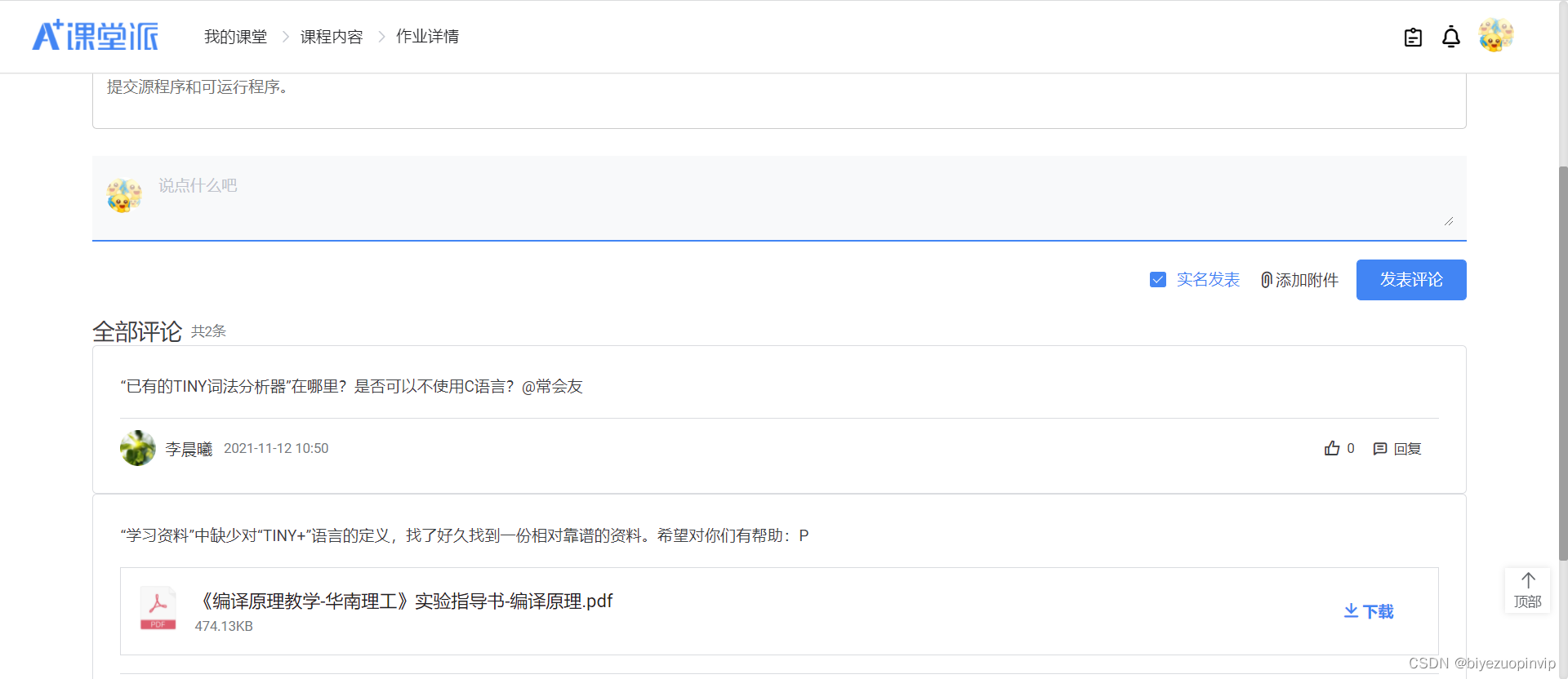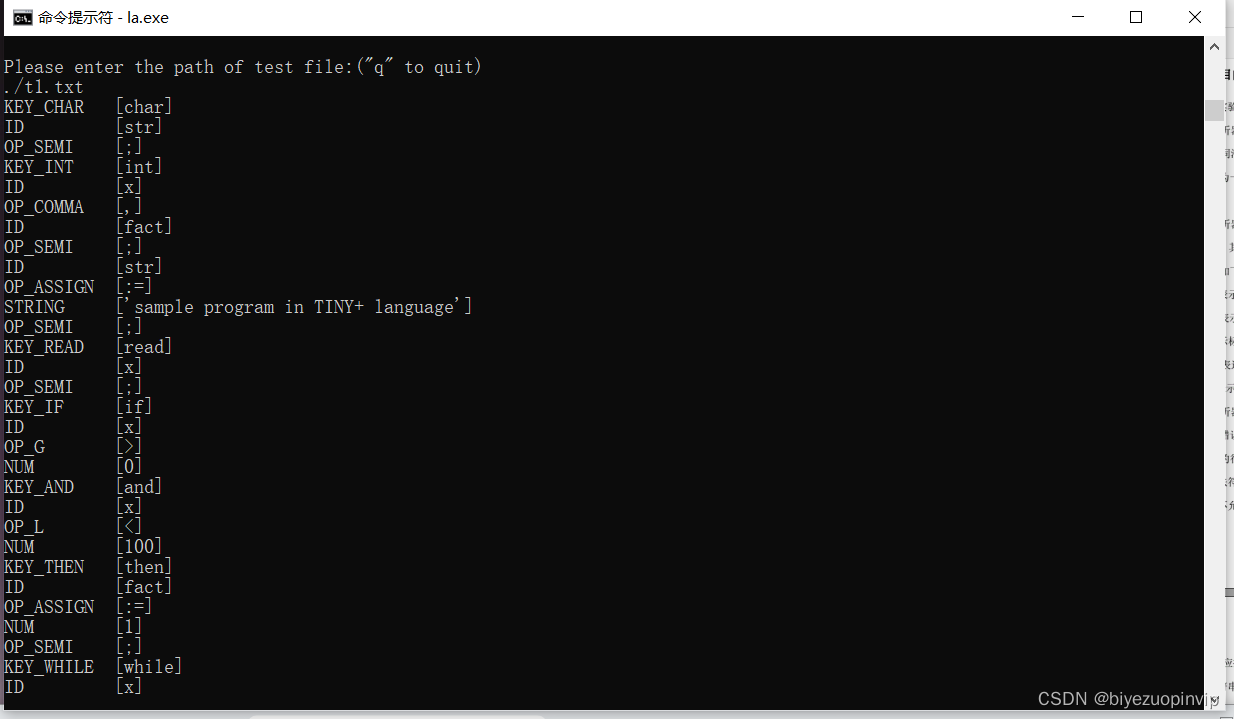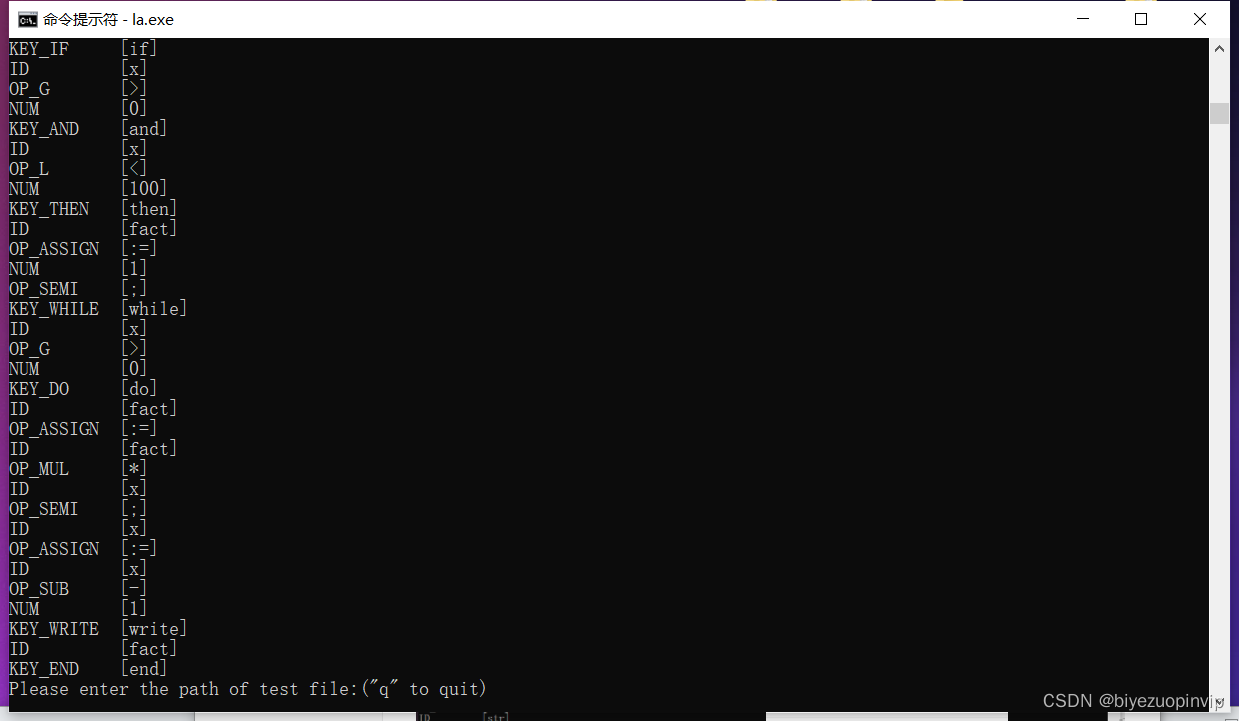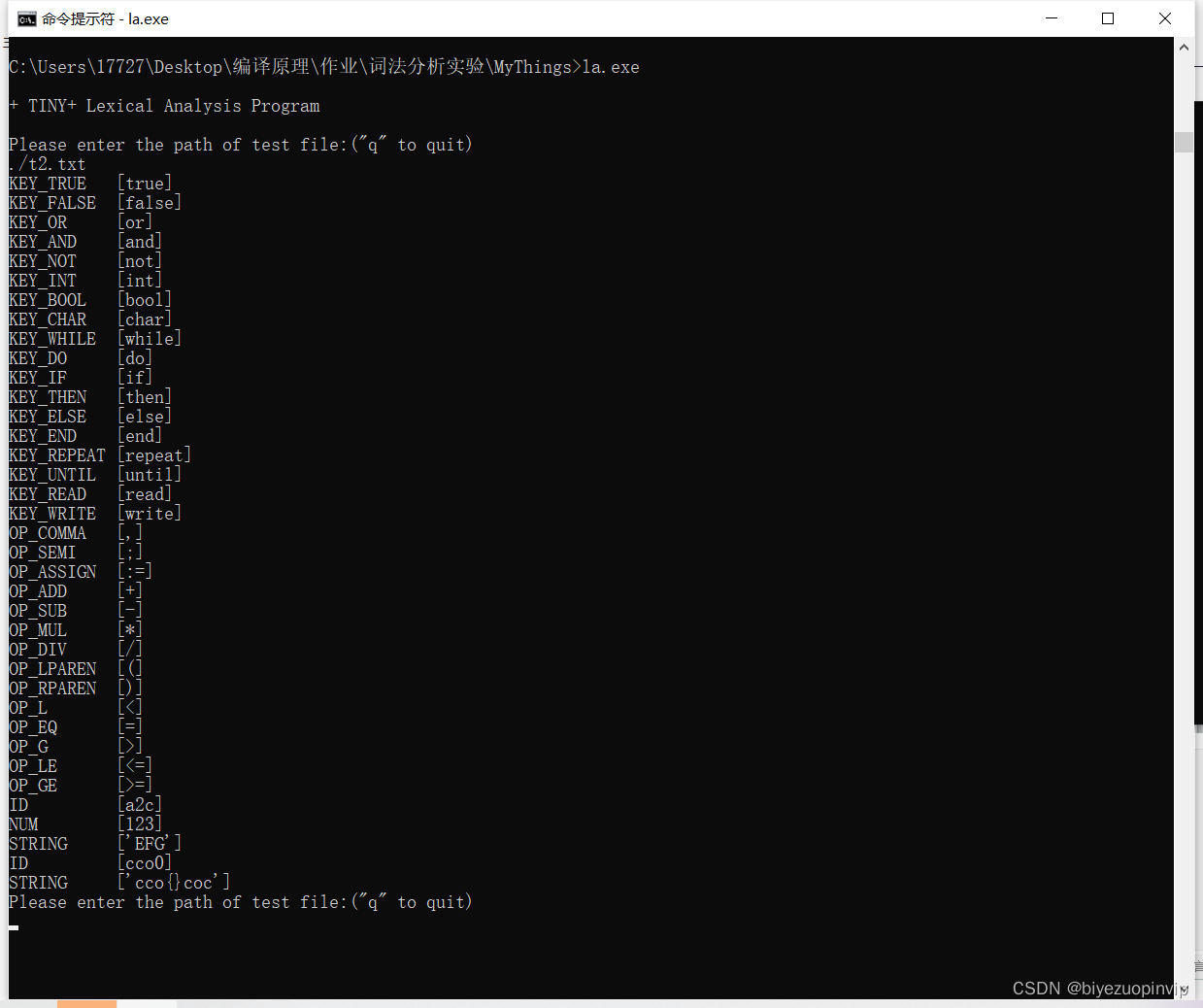资源下载地址:https://download.csdn.net/download/sheziqiong/86873815
资源下载地址:https://download.csdn.net/download/sheziqiong/86873815
编译原理 词法分析实验
一、实验说明
词法分析程序实验:
- 实验目的:通过扩充已有的样例语言TINY语言的词法分析程序,为扩展TINY语言TINY+构造词法分析程序,从而掌握词法分析程序的构造方法
- 实验内容:了解样例语言TINY及TINY编译器的实现,了解扩展TINY语言TINY+,用C语言在已有的TINY词法分析器基础上扩展,构造TINY+的词法分析程序。
- 实验要求:将TINY+源程序翻译成对应的TOKEN序列,并能检查一定的词法错误。
提交源程序和可运行程序。
二、TINY+词法定义
来源:同学在作业连接下分享的文件

2.1 关键字
关键字包括:(小写)
or, and , int, bool, char, while, do, true, false
if, then, else, end, repeat, until, read, write
2.2 操作符
操作符包括:
>, <=, >=, <, =
,, ', {, }, ;, :=
(,), +, -, *, /
2.3 分隔符
空格符包括: , \t, \n,在词法分析后不被保留。
2.4 其他符号
其他符号有四种,他们的正则定义如下:
- 标识符
ID:letter(letter|digit)* - 数字
NUM:digit digit* - 字符串
STRING:'any char except ' '(不能跨行定义) - 注释:
{...}(用花括号标注,可以跨行定义)
三、程序说明
3.1 编译运行
Windows下运行
gcc la.c -o la.exe a.exe测试文件位于
\test文件夹
3.2 数据定义
程序中定义的 TOKEN 类型
// Keyword tokens // |-18 Keywords-----------| KEY_OR, KEY_AND, KEY_NOT, // | or | and | not | KEY_INT, KEY_BOOL, KEY_CHAR, // | int | bool | char | KEY_WHILE, KEY_DO, // | while | do | | KEY_IF, KEY_THEN, KEY_ELSE, // | if | then | else | KEY_END, KEY_REPEAT, KEY_UNTIL, // | end | repeat| until | KEY_READ, KEY_WRITE, // | read | write | | KEY_TRUE, KEY_FALSE, // | true | false | | // Operator tokens // |-17 Operators-| OP_G, OP_L, OP_ASSIGN, // | > | < | := | OP_GE, OP_LE, OP_EQ, // | >= | <= | = | OP_COMMA, OP_QUOTA, OP_SEMI, // | , | ' | ; | OP_LPAREN, OP_RPAREN, // | ( | ) | | OP_LBRACE, OP_RBRACE, // | { | } | | OP_ADD, OP_SUB, // | + | - | | OP_MUL, OP_DIV, // | * | / | | // Other tokens // |-Each NF--------------------|-Example-| ID, // | letter(letter|digit)* | c1 | NUM, // | digit digit* | 123 | STRING, // | ' any character except' ' | 'hi!' | NONE, // | | 1c | ANNO // | { any character } | {hi} | };并提供相关函数获取TOKEN_TYPE,其字符串形式
char* getTokenName(enum TOKEN_TYPE i); enum TOKEN_TYPE getTokenType(char *token);以下是词法分析有关数据结构
typedef struct TOKEN{ // TOKEN 二元组 enum TOKEN_TYPE type; // 词素 char info[SIZE_2]; // 含义 }TOKEN; FILE* file; // 待分析文件的指针 TOKEN file_tokens[SIZE_1]; // 保存词法分析结果 int file_tokens_num; // 分析的TOKEN总数 int current_row; // 当前扫描位置(行数) int current_col; // 当前扫描位置(列数) char current_word[SIZE_2]; // 当前扫描得到的单词 int current_word_ptr; // 当前扫描单词的长度 enum TOKEN_TYPE current_type; // 当前的预测TOKEN类型 int operator_flag = 0; // 操作符标记 int error; // 词法分析错误处
3.3 核心函数
/**
* 初始化:为所有用到的变量(@line 136- 147)赋初始值,若文件无啊打开,提示报错。
* @param file_path
* @return 1 if the file is opened successfully, otherwise 0.
*/
int la_initial(char file_path[]);
/**
* 根据当前的 current_word 和 current_type 生成 Tokens 并保存在 file_tokens 中。
*/
void la_make_token();
/**
* 输出词法编译结果:显示出错原因和出错位置(几行几列)
* @param message 出错信息
* @param row 出错位置(行数)
* @param col 出错位置(列数)
*/
void la_show_error(const char* message, int row, int col);
/**
* 在扫描新的一行时进行预处理
*/
void la_update_line();
/**
* 根据下一个字符 c 来更新 current_word 和 current_type。
* @param c lookahead symbol
*/
void la_update_word(char c);
/**
* 词法分析入口:执行文件字符扫描和词法分析,在出现错误时或读完程序时终止
*/
void la_start();
3.4 主函数
用户可以输入文件地址,每次输入一个文件路径,程序读取文件内容并作语法分析,将词法分析结果直接输出。
核心部分代码:
if(la_initial(file_path)){ // 1、初始化,若成功则进入词法分析 la_start(); // 2、执行词法分析 if(error == 0) // 3、若没有错误出现 la_show_result(); // 4、则输出TOKEN序列 }
四、测试效果
测试 1
测试一段普通的TINY+程序的词法分析结果
char str; int x, fact; str:= 'sample program in TINY+ language'; read x; if x > 0 and x < 100 then { don't do it } fact:=1; while x > 0 do fact:=fact*x; x:=x-1 write fact end测试结果:如下图所示。


测试 2
- 测试内容:测试所有关键字和运算符,并给出几个比较特殊的嵌套例子:
{cc'oo'o}、'cco{}coc'
true false or and not
int bool char while do
if then else end repeat
until read write , ;
:= + - * /
( ) < = >
<= >= a2c 123 'EFG'
{cc'oo'o} cco0 'cco{}coc'
- 测试结果:所有词都被正确识别并转化为Token

测试 3
测试内容:测试击中错误代码,分别保存在
t3.txt,t4.txt,t5.txt,t6.txt中。$ hello 123hello hello' hello}它们分别代表:非法字符输入、非法ID、字符串不完整、注释不完整。
测试结果:

资源下载地址:https://download.csdn.net/download/sheziqiong/86873815
资源下载地址:https://download.csdn.net/download/sheziqiong/86873815
本文含有隐藏内容,请 开通VIP 后查看